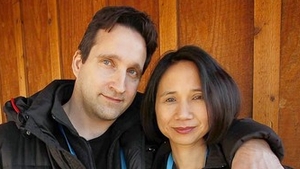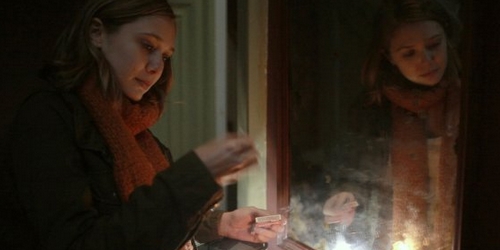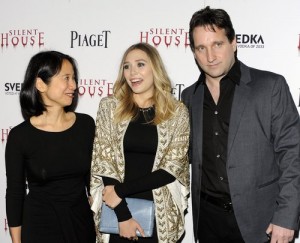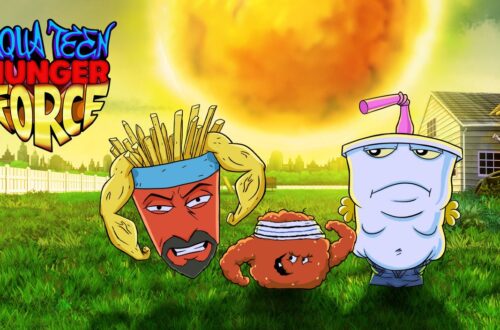 In conjunction with the release of Open Road’s one-take horror exercise, Silent House, I was presented with the opportunity to interview Chris Kentis and Laura Lau, the writer-director team behind the film, who many will remember as the duo behind 2003’s Open Water. I can’t deny that I was nervous; this marks my very first interview, for GoSeeTalk and in general, so naturally I felt anxious and a lot of pressure to represent myself, GST, and, ultimately, my subjects well. Luckily for me, Mr. Kentis and Ms. Lau made for one great, insightful, informative interview, providing a ton of detail about the process of making Silent House and working with star Elizabeth Olsen. Whether you’ve seen the film or not, their thoughts on the process of shooting Silent House make for some fascinating reading– so take a look and see what they had to say!
In conjunction with the release of Open Road’s one-take horror exercise, Silent House, I was presented with the opportunity to interview Chris Kentis and Laura Lau, the writer-director team behind the film, who many will remember as the duo behind 2003’s Open Water. I can’t deny that I was nervous; this marks my very first interview, for GoSeeTalk and in general, so naturally I felt anxious and a lot of pressure to represent myself, GST, and, ultimately, my subjects well. Luckily for me, Mr. Kentis and Ms. Lau made for one great, insightful, informative interview, providing a ton of detail about the process of making Silent House and working with star Elizabeth Olsen. Whether you’ve seen the film or not, their thoughts on the process of shooting Silent House make for some fascinating reading– so take a look and see what they had to say!
Andrew Crump: I understand that Silent House is a remake of a Uruguayan film of the same name, and I’m curious—what about that film drew you to this project and inspired you to make Silent House? Was it the narrative elements of the original picture or the technical challenge in filming a movie in one uninterrupted take?
Chris Kentis: You know, we were actually approached by the producer who has the remake rights of the original film, and she was a fan of Open Water. She contacted us and mentioned that, for example, the film was a single take movie, and we were immediately interested by that. So, she sent us the movie, and we were very impressed by what they’d done, but we wanted to go in a different direction story-wise; everything’s always about story, so it was important that this single-take format be suited to a specific kind of story. Laura took on the script—do you want to speak to that?
Laura Lau: That’s a good question. Obviously, we were very intrigued by the idea of telling a story in one continuous take; we definitely haven’t seen a lot of films like that.
CK: It’s a really different way to make a movie. We had to really rethink how to put the film together, because traditionally all films have been made through cutting in the editing room.
AC: So it was that idea of trying to do something non-traditional and breaking away from using editing and cuts to put the film together?
CK: Yeah, it was the challenge of that and trying to figure out a whole new film language. First of all, we have to control pacing and figure that all out in rehearsals, and then, you know, making all kinds of choices that you’re going to have to live with down the line, because what you get in the production is what’s going to be the film. But the more intriguing thing was the chance to give the audience a brand new experience, something that they’ve never seen before. I don’t think there’s been a mainstream genre picture that’s been done in a single take. There have been art films like Russian Ark, or Rope, but that was 1948 and it was a different genre.
AC: You mentioned that you went in a different direction with the story from the original film—I think it’s called La Casa Muda. How much did you stick that film and how much did you alter? Were you more concerned with making the film your own or sticking to the original version?
LL: Well, the original was based on a true story that the director had heard about, about a family who was murdered in a house [other details omitted for spoiler purposes], and they actually stayed away from that while I really embraced those elements. For people to kill each other, something very, very wrong has to happen, so I started to really research and look into what could have happened and what happens when abuse happens at a young age and became fascinated by what happens to a person who’s fragmented through trauma. I thought that the continuous shot was a way to really bring across her experience.
So there were elements in the original that worked, and we preserved those. But we were charged to do a remake, so while we wanted to hold those elements in mind, we were definitely given the freedom to make it our own.
AC: It’s interesting, you’re talking about using that continuous talk to show the main character’s breakdown and show where she starts at the beginning and where she ends up at the end. You have, which I thought was a great choice, Elizabeth Olsen as your star. She’s been on people’s radars since Martha Marcy May Marlene, and I think you got a really strong performance out of her here. What was it like working with Olsen and how did she handle the film’s technical demands and the constraints they imposed on her?
LL: It was definitely very challenging for Lizzie. It was an unusual way to make a film for everybody involved in the production, but I think for Lizzie, knowing that the film is about a very hurt, very damaged human being, she was always carrying that with her. This is a character who, because of her damaged mind, her whole sense of time as a traumatized person, doesn’t know the difference between past and present. So sometimes she’s bringing the fear of a terrified little girl. The whole film is really her journey, so Lizzie was carrying that along with the film’s technical demands, no question.
It was extremely demanding. She had to bring a tremendous amount of emotion. She was actually having nightmares, and we were using some of the content of her nightmares in the film. We actually integrated some of it into the script. So I think it was very immersive for her, and it was really tough in every way for her. It was challenging physically because the takes were very, very long, and as Chris said, if any mistakes were made, we had to go back to square one. So, she could have given an unbelievable performance and if one person got their hand in the shot or a lighting guy missed their queue, then the shot was no good and we’d have to go back, and we were always at least into the teens before we were able to get any of these long sequences, and sometimes into the thirties. Lizzie, every time, had to bring everything, and it was very hard on her. She was amazing—her ability to concentrate, her stamina, and of course how willing she was to give herself to the role.
(At this point, I asked if they could give specifics regarding what parts of the films were influenced by Olsen’s nightmares, which go into full-on but totally fascinating spoiler territory.)
AC: I wanted to ask about the challenges of trying to shoot a movie that abstains from cuts and you guys both have touched on that a bit already. Were there any challenges that were specific to your experience in filming Silent House?
CK: Well, every shot was complex and different and so they all had their own unique challenges. One example that comes to mind is where she’s in the basement and she runs outside, runs through the field, and she sees a little girl, and she runs into Peter’s car and then they go back to the house. To do that sequence, we had a cameraman following her into the basement and all through the field. Then, when they got to the car, there was another camera operator waiting in the car, so the original camera operator passed the camera to the operator in the car and then climbed onto the back of the car and the car drove up to the house. Then, when the character Peter, who’s driving the car, opens the door to leave, we switched the operator on the back of the car into the driver’s seat and the operator in the back seat passed the camera to the operator in the driver’s seat. Then, when Peter opens the trunk, the other operator got out of the car and waited by the side. As the scene played out, and Lizzie left the car and went back inside the house, the operator in the driver’s seat passed the camera to the operator waiting outside and they went back into the house to continue doing scenes in the house.
It’s just one example of the ballet that had to take place, both technically and in working with the actors. The trickiest part of that shot is that the picture starts in lightness, and then the character gets trapped in this dark house. It’s really a metaphor—the darkness that she’s going to have to face is something you can’t outrun, and so when she escapes from the basement into the daylight, we wanted that darkness that she just can’t run away from to envelope her, and of course the only way to do that is to shoot as the sun is going down. So within that shot, it goes from daytime to nighttime. Timing that and getting that shot was an immensely difficult challenge.
AC: It sounds like an enormous amount of work, and from start to finish I was really impressed at how seamless everything was, so hearing all the things you’re telling me really put that into an even greater perspective. It kind of reminds me more of live theater than straight cinema, which I think is really interesting for mainstream horror these days.
CK: Thank you. And like I said, we were trying to give a different kind of experience, and hopefully audiences don’t care or even notice that it’s a single take. They just that something about this movie felt a little different and touched them in a different kind of way.
LL: Yeah, and obviously we do hope that people actually won’t just notice the single shot and be involved with her story and have something more to think about when they go home.
AC: At this point that’s all that I have, so I’ll let you guys go. Thank you very much for your time!
LL: You’re welcome, and we really appreciate you writing about the film!
Special thanks again to both Chris and Laura for their time, and also a tip of the hat from GoSeeTalk to Open Road for giving us the chance to get on the phone together!






2 Comments
Fogs' Movie Reviews
Crazy! Good job man. You should make those spoilers discussions available for people who have seen the film though, I would definitely like to hear that part of the discussion.
Congrats on your first interview, you did great. A very nice read.
It is actually fascinating from a production standpoint how they were able to accomplish this. That’s good stuff to read.
I’m surprised this once had its roots in a true story. Huh. I’m not the hugest fan of the ending, perhaps because the power of the rest of the story came from the immediacy of it all, the relative realism… still, it gets me a little closer as to the why on that creative choice.
Well done sir. Well done.
Andrew Crump
Thanks Dan! Little detail– I had no idea that this was actually going to happen until I received the call from Chris and Laura. I was actually really close to just heading back to work from my lunch break. I’m so glad things worked out because I had a great experience talking to them.
Chris and Laura shed a TON of light on how much it took to get just an 88 minute film in the can. If nothing else I have to respect the film for what the crew and the cast endured to get it done. Really ballsy, and really challenging.
I may eventually open up those spoilery details– in fact almost certainly I will as I still have the interview recorded and saved on my computers– but I’m going to give the movie time to gestate first.